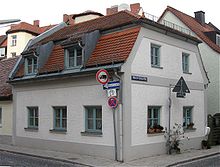Feldmüllersiedlung
The Feldmüller estate is a residential area in the Munich district of Obergiesing . It is registered as a listed ensemble in the Bavarian list of monuments.
location
The Feldmüller settlement is located between Tegernseer Landstrasse , Gietlstrasse (previously: Gottesackerweg), the vicarage on Ichostrasse (previously: Pfarrhofgasse) and the neo-Gothic Holy Cross Church .
The parcels for the Feldmüllersiedlung were arranged according to a street grid that still today consists of Gietlstrasse, Ichostrasse, Aignerstrasse, Unterer Grasstrasse, Oberer Grasstrasse and Kiesstrasse. This residential area was created on the other side of the Obergiesing town center.
history
The Feldmüller settlement consists of small houses that were built between 1830 and 1860.
This quarter is named after Therese Feldmüller, who lived in Giesing from 1840 to 1846 . She owned the land, which she sold piece by piece to craftsmen , day laborers who moved in and small businesses . They built simple, one-story houses close to each other on the plots - some with businesses in the backyard, some with small gardens.
The Feldmüllersiedlung thus formed a clear contrast to the rural buildings in the old town center in the immediate vicinity. Since such workers' quarters often only emerged after the First World War , the Feldmüller settlement is a specialty throughout Germany according to the Bavarian State Office for the Preservation of Monuments .
The residents of the Feldmüller estate benefited from the construction boom of the Wilhelminian expansion of the city from around 1880, so that some houses were increased (Kiesstrasse 5 and 6, Obere Grasstrasse 5, 6 and 8).
The garden restaurant "Kriegerheim" (corner of Gietlstrasse / Untere Grasstrasse) initially served the Obergiesing communists as a meeting place. Later the "Kriegerheim" became the meeting place of the Giesingen NSDAP local group .
The MGS (Munich Society for Urban Renewal) was commissioned by the Munich city council in 1983 to renovate the listed Feldmüller estate. In 1984 the quarter was declared a redevelopment area.
MGS was able to carry out the redevelopment of the district with the “hostel program”, which was funded by the city with 2.5 million euros.
In 2017, the illegal demolition of the watchmaker's house in Obere Grasstrasse 1 generated a lot of media coverage.
Web links
- Feldmüllersiedlung on: muenchen.de
- Feldmüllersiedlung on: stadt-muenchen.net
swell
Individual evidence
- ↑ Bavarian State Office for the Preservation of Monuments (ed.): Bavarian Monument Atlas, file number E-1-62-000-12.
- ↑ a b c d e f Redevelopment of the Feldmüller estate in Giesing. ( Page no longer available , search in web archives ) Info: The link was automatically marked as defective. Please check the link according to the instructions and then remove this notice. Munich Society for Urban Renewal (MGS), Munich July 2006. (PDF file; 1.6 MB)
- ↑ a b Feldmüller settlement. on: stadt-muenchen.net
- ↑ a b Haidhausen · Do you know Munich? With the MVHS through the Feldmüllersiedlung. Report on a guided tour of the Munich adult education center through the Feldmüller settlement on: wochenanzeiger.de
- ↑ a b c d e The Feldmüller settlement. on: muenchen.de
- ↑ a b c d Urban redevelopment Munich (3): Fresh air for a rotten district. Report on the redevelopment of the Feldmüller settlement on sueddeutsche.de
- ↑ Hubert Grundner: Construction company destroys part of the old Giesing. In: Süddeutsche Zeitung. September 3, 2017. Retrieved September 3, 2017 .
- ^ OB Reiter: Demolition of the craftsman's house in Giesing "a scandal" . TZ. September 4, 2017. Retrieved September 5, 2017.
- ↑ A listed building in Munich flattened ( memento from January 21, 2018 in the Internet Archive ). BR. 4th September 2017.
Coordinates: 48 ° 6 ′ 59 ″ N , 11 ° 34 ′ 45 ″ E


